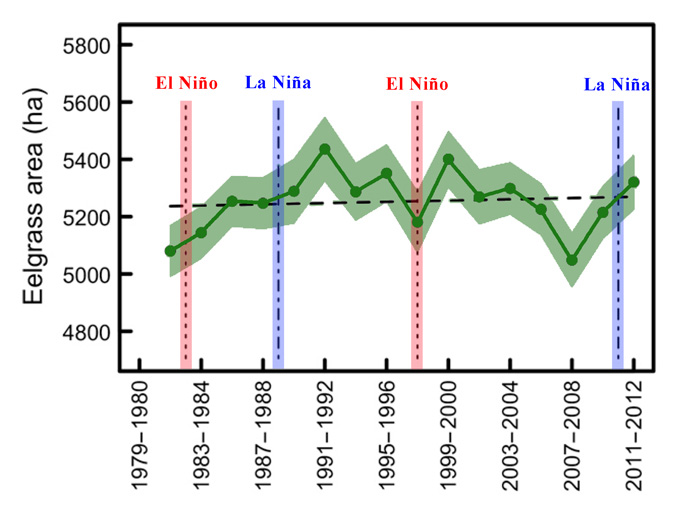| Follow @co2science |
Paper Reviewed
Shelton, A.O., Francis, T.B., Feist, B.E., Williams, G.D., Lindquist, A. and Levin, P.S. 2017. Forty years of seagrass population stability and resilience in an urbanizing estuary. Journal of Ecology 105: 458-470.
According to the last U.S. National Climate Assessment report published in 2014 (Melillo et al., 2014), there is "very high confidence that coastal ecosystems are particularly vulnerable to climate change because they have already been dramatically altered by human stresses, as documented in extensive and conclusive evidence" (Moser et al., 2014). Additionally, the report claims there is "very high confidence that climate change will result in further reduction or loss of the services that these ecosystems provide, as there is extensive and conclusive evidence related to this vulnerability" (Moser et al., 2014).
One type of ecosystem that has received considerable attention in this regard is the seagrass biome. Found in numerous coastal waters, including those of the United States, seagrasses play a critical role in both temperate and tropical coastal ecosystems. As a foundational species they provide food and habitat to sustain a wide variety of marine life and their presence helps to reduce coastal erosion, improve water quality and mediate ocean chemistry, as well as to generate considerable economic value to the human economy. Given the important functions that they perform within their coastal ecosystems, it should come as no surprise, therefore, that concerns have arisen over the current and future ability of seagrass ecosystems to withstand the so-called twin evils of rising atmospheric CO2 concentrations - global warming and ocean acidification. But are such concerns valid?
A new study by Shelton et al. (2017) sheds some important light in this regard. Working with over 160,000 observations from Puget Sound, Washington, USA, the team of six researchers created a database of eelgrass (Zostera spp.) change along hundreds of kilometers of shoreline over the 41-year period 1972-2012. Their hope was that, through a series of statistical analyses performed on their dataset, they would be able to ascertain the natural and anthropogenic factors contributing to eelgrass change across various spatial and temporal scales.
And what did their analysis reveal?
At the site (1-10 km) and subsite (0-1 km) level, Shelton et al. report there were "substantial changes" in eelgrass populations over the four decades of study. Yet, at these smaller spatial scales they say there was "no obvious geographic coherence in [the] trends," noting that adjacent eelgrass sites sometimes had opposite trends. This lack of geographic coherence, according to Shelton et al., "would [not] be expected if shared oceanographic or climate drivers controlled eelgrass trends," suggesting that something other than climate change or ocean acidification must be controlling the opposing trends observed at these smaller scales in their analysis.
Scaling up to the regional level and covering the entire estuary, Shelton et al. report, as illustrated in the figure below, that "over the past 40 years, eelgrass in Puget Sound has proven resilient to large-scale climatic and anthropogenic change," confirming once again that "we do not see coincident changes in eelgrass populations that would indicate a major shared climatic driver across sites."
This large-scale stability of eelgrass populations observed in the Puget Sound estuary over the past four decades, which has endured despite (1) a more than doubling of the human population in the area and (2) multiple major oceanographic anomalies (including several major El Niño and La Niña events), is a testament to the adaptability and resilience of this keystone marine ecosystem species. Furthermore, such findings call into question the "very high confidence" (or perhaps we should say hubris) that the U.S. National Climate Assessment assigns to predictions of future coastal ecosystem demise in response to CO2-induced global warming and ocean acidification. The reality is that estimates of such vulnerability are largely overstated. One can only hope that the forthcoming 2018 U.S. National Climate Assessment will temper such projections by incorporating the realism observed in nature from studies like that of Shelton et al.

Figure 1. Cumulative eelgrass area across the Puget Sound estuary over the period 1979-2012. Vertical dotted lines shaded in red indicate major El Niño events (1982-1983 and 1997-1998) and dash-dot lines shaded in blue indicate major La Niña events (1988-1989 and 2010-2011). Adapted from Shelton et al. (2017).
References
Melillo, Jerry M., Terese (T.C.) Richmond, and Gary W. Yohe, Eds., 2014: Climate Change Impacts in the United States: The Third National Climate Assessment. U.S. Global Change Research Program, 841 pp. doi:10.7930/J0Z31WJ2.
Moser, S. C., M. A. Davidson, P. Kirshen, P. Mulvaney, J. F. Murley, J. E. Neumann, L. Petes, and D. Reed, 2014: Ch. 25: Coastal Zone Development and Ecosystems. Climate Change Impacts in the United States: The Third National Climate Assessment, J. M. Melillo, Terese (T.C.) Richmond, and G. W. Yohe, Eds., U.S. Global Change Research Program, 579-618. doi:10.7930/J0MS3QNW.
Posted 30 May 2017



